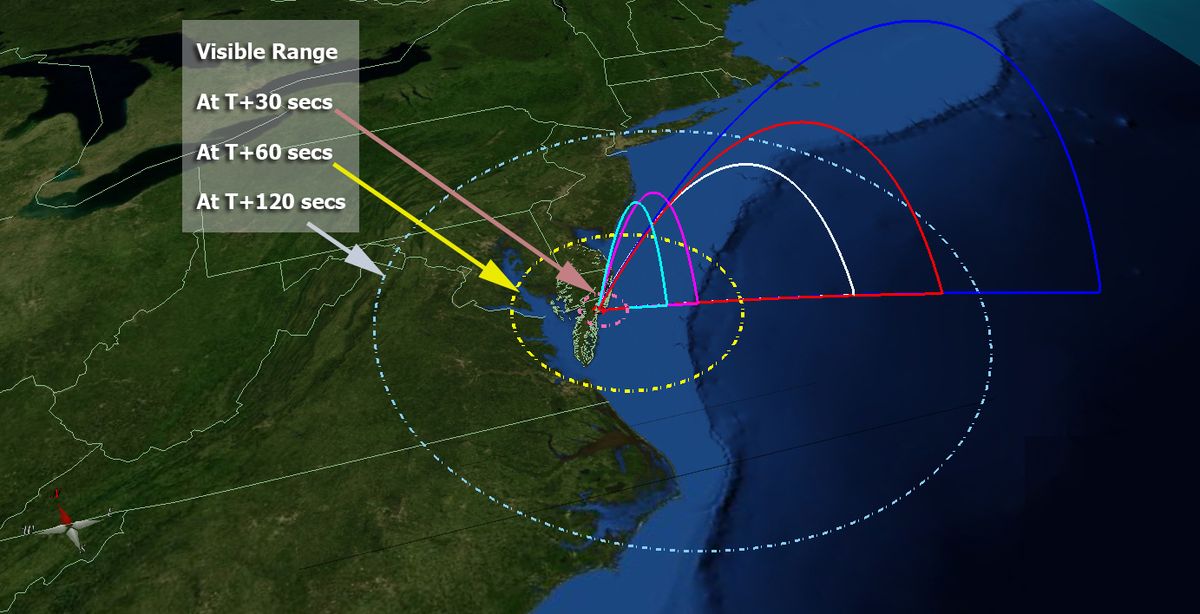
NASA will launch five rockets in five minutes Wednesday (March 14) to study fast-moving winds at the edge of space, and many skywatchers along the United States' mid-Atlantic coast will be able to watch the show.
The unmanned rocket barrage, which is slated to blast off late Wednesday from NASA's Wallops Flight Facility in Virginia, forms the core of the agency's Anomalous Transport Rocket Experiment, or ATREX. The five suborbital rockets will release chemical tracers between 50 to 90 miles (80 to 145 kilometers) up to track high-altitude winds, which can zip around the planet at more than 300 mph (483 kph).
These tracers will create milky-white clouds that should be visible to folks on the ground from parts of South Carolina up through New Jersey, researchers said.
"They occur in the middle of the night, and they glow," ATREX principal investigator Miguel Larsen, of Clemson University, told reporters March 7. "It's not extremely bright, but it's definitely visible."
Mysterious winds at the edge of space
ATREX aims to probe the high-altitude jet stream, which whistles along 60 to 65 miles (97 to 105 km) above Earth's surface.
This river of air blows much higher up than the jet stream commonly referred to in weather forecasts, which is found at an altitude of just 6 miles (10 km) or so. And it's much stronger, too, with winds routinely exceeding 200 mph and occasionally topping 300 mph. [Infographic: Earth's Atmosphere – Top to Bottom]
Sign up for the Live Science daily newsletter now
Get the world’s most fascinating discoveries delivered straight to your inbox.
Theory suggests that the high-altitude jet stream should travel at just 50 mph (80 kph), Larsen said. ATREX aims to help scientists understand why their predictions are so far removed from reality.
"The reason for doing this mission is that we really don't understand why there are such large winds at those heights," Larsen said.

A five-rocket fusillade
The $4 million ATREX mission will launch five sounding rockets over the Atlantic Ocean within a span of five minutes and 20 seconds. While the rockets' trajectories are different, they'll all release their tracer — a chemical called trimethyl aluminum — roughly simultaneously, researchers said. Two of the rockets will also carry instruments that measure temperature and atmospheric pressure.
Three different cameras, one at Wallops and one each in North Carolina and New Jersey, will track the tracer clouds, measuring how quickly they move away from each other. This information should give scientists a better idea of what's driving the hyper-fast winds.
The launch will occur at night under clear skies, to make sure the cameras have a clear view of the glowing tracer clouds. That means many skywatchers along the East Coast will get a good look, too.
The tracers should be visible for about 20 minutes after launch to viewers within 250 miles (402 km) or so of Wallops, Larsen said.
The ATREX launch window extends from March 14 through April 3, opening no earlier than 11 p.m. EST (0400 GMT) each night and closing no later than 6:30 a.m. EST (1130 GMT) the following morning.
NASA will broadcast the five ATREX launches online live, with coverage beginning two hours before the opening of the launch window. The webcast will be available here: http://sites.wff.nasa.gov/webcast
The rockets being used for the mission are two Terrier-Improved Malemutes, two Terrier-Improved Orions and one Terrier-Oriole. All will fall harmlessly into the Atlantic after they release the trimethyl aluminum. The chemical poses no threat to the environment or human health, researchers said.
This story was provided by SPACE.com, a sister site to LiveScience. You can follow SPACE.com senior writer Mike Wall on Twitter: @michaeldwall. Follow SPACE.com for the latest in space science and exploration news on Twitter @Spacedotcom and on Facebook.












